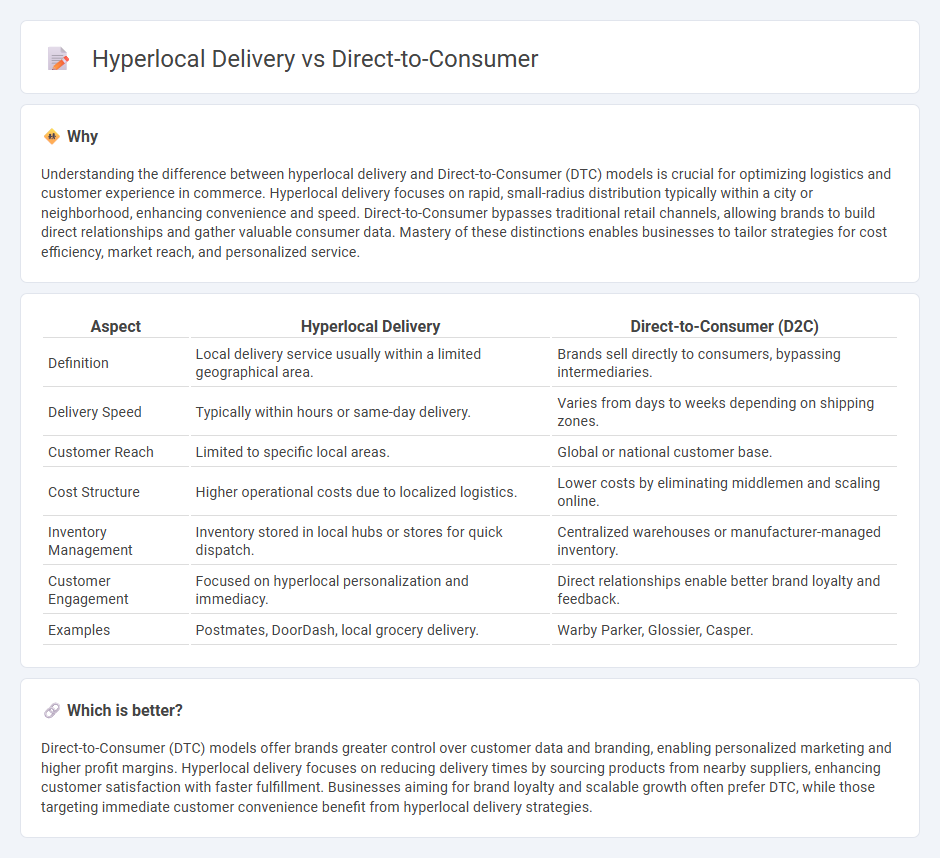
Hyperlocal delivery focuses on fulfilling orders within a limited geographic area, ensuring faster delivery times and supporting local businesses. Direct-to-Consumer (DTC) models bypass traditional retail channels, allowing brands to build direct relationships with customers and collect valuable data. Explore the benefits and challenges of both approaches to optimize your commerce strategy.
Why it is important
Understanding the difference between hyperlocal delivery and Direct-to-Consumer (DTC) models is crucial for optimizing logistics and customer experience in commerce. Hyperlocal delivery focuses on rapid, small-radius distribution typically within a city or neighborhood, enhancing convenience and speed. Direct-to-Consumer bypasses traditional retail channels, allowing brands to build direct relationships and gather valuable consumer data. Mastery of these distinctions enables businesses to tailor strategies for cost efficiency, market reach, and personalized service.
Comparison Table
| Aspect | Hyperlocal Delivery | Direct-to-Consumer (D2C) |
|---|---|---|
| Definition | Local delivery service usually within a limited geographical area. | Brands sell directly to consumers, bypassing intermediaries. |
| Delivery Speed | Typically within hours or same-day delivery. | Varies from days to weeks depending on shipping zones. |
| Customer Reach | Limited to specific local areas. | Global or national customer base. |
| Cost Structure | Higher operational costs due to localized logistics. | Lower costs by eliminating middlemen and scaling online. |
| Inventory Management | Inventory stored in local hubs or stores for quick dispatch. | Centralized warehouses or manufacturer-managed inventory. |
| Customer Engagement | Focused on hyperlocal personalization and immediacy. | Direct relationships enable better brand loyalty and feedback. |
| Examples | Postmates, DoorDash, local grocery delivery. | Warby Parker, Glossier, Casper. |
Which is better?
Direct-to-Consumer (DTC) models offer brands greater control over customer data and branding, enabling personalized marketing and higher profit margins. Hyperlocal delivery focuses on reducing delivery times by sourcing products from nearby suppliers, enhancing customer satisfaction with faster fulfillment. Businesses aiming for brand loyalty and scalable growth often prefer DTC, while those targeting immediate customer convenience benefit from hyperlocal delivery strategies.
Connection
Hyperlocal delivery enhances the Direct-to-Consumer (D2C) model by enabling faster and more efficient product distribution within localized areas, reducing delivery times and costs. This proximity-driven approach strengthens customer relationships through personalized service and immediate fulfillment, boosting brand loyalty. Integration of hyperlocal logistics with D2C strategies leverages real-time inventory management and data analytics to optimize supply chains and improve the overall consumer experience.
Key Terms
Distribution Channel
Direct-to-Consumer (D2C) models streamline distribution channels by selling products directly to customers, eliminating intermediaries and reducing delivery time through centralized fulfillment centers. Hyperlocal delivery emphasizes proximity-based distribution, leveraging local stores and delivery partners to provide faster, on-demand service within specific geographic areas. Explore how these distinct distribution strategies impact customer experience and operational efficiency in modern retail.
Last-Mile Delivery
Direct-to-Consumer (DTC) delivery models prioritize shipping products directly from the manufacturer or warehouse to the end customer, optimizing supply chain efficiency for broad geographic coverage. Hyperlocal delivery emphasizes ultra-fast fulfillment within a limited neighborhood or city radius, leveraging local inventory and real-time routing to minimize last-mile transit times. Explore how integrating these strategies can revolutionize last-mile delivery performance and customer satisfaction.
Customer Proximity
Direct-to-consumer (DTC) delivery emphasizes a streamlined supply chain by shipping products directly from the manufacturer to customers, reducing intermediaries and enhancing speed. Hyperlocal delivery centers on immediate geographic proximity, leveraging local stores or warehouses to fulfill orders rapidly within a limited radius, often within hours. Explore how these models differ in operational efficiency and customer experience to determine the ideal approach for your business.
Source and External Links
Direct-to-consumer - Wikipedia - Direct-to-consumer (DTC) is a business model where brands sell products directly to customers, bypassing third-party retailers or wholesalers, and is often done online but can include physical retail spaces as part of an omnichannel approach, with U.S. DTC e-commerce sales exceeding $128 billion in 2021.
What Is Direct-to-Consumer? Everything You Need To Know (2024) - The DTC model involves brands selling directly to consumers through their own websites or digital channels, giving them full control over the customer experience, fulfillment, marketing, and customer data, often focusing on building direct relationships and loyalty.
Direct to Consumer (DTC) Definition - Glossary - CDP.com - DTC is a sales strategy where brands sell directly to consumers instead of through retailers or wholesalers, a shift accelerated by the growth of ecommerce and the pandemic; some traditional brands have adopted DTC alongside or in place of traditional retail channels.
 dowidth.com
dowidth.com